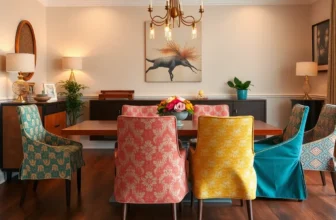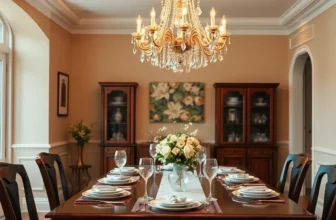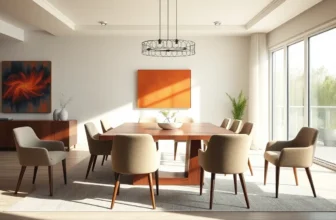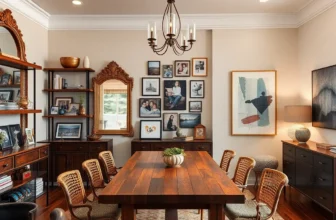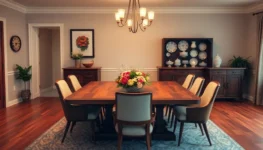
Essential Dining Room Furniture Tips for a Stylish and Functional Space
The dining room is more than just a place to eat; it’s where families gather, friends connect, and memories are made. Choosing the right dining room furniture can transform this essential space into a warm and inviting environment. From elegant tables to comfortable chairs, the right pieces not only enhance the room’s aesthetic but also reflect personal style and functionality.
With countless options available, selecting the perfect dining room furniture can feel overwhelming. Understanding the various styles, materials, and layouts can help simplify the decision-making process. Whether someone prefers a modern look or a classic vibe, the right choices can elevate the dining experience and create a welcoming atmosphere for all.
Dining Room Furniture
Dining room furniture consists of essential pieces that define the space’s functionality and aesthetic appeal. Key components include tables, chairs, sideboards, and buffets.
- Tables: Dining tables vary in shape, size, and material. Round tables accommodate small gatherings, while rectangular tables suit larger spaces. Common materials include wood, glass, and metal, each offering distinctive styles and durability.
- Chairs: Dining chairs enhance comfort and support during meals. Styles range from upholstered armchairs to sleek wooden designs. Selecting chairs that match the table style and desired comfort level promotes a cohesive look.
- Sideboards: Sideboards serve as additional storage and display space. These pieces often feature shelves and drawers, ideal for storing tableware and serving dishes. They also offer a surface for decorative items, enhancing the room’s overall style.
- Buffets: Buffets provide a practical solution for serving meals. They typically have a flat surface for setting food and drinks. Many buffets include storage options for crockery, glassware, and utensils, making them functional and stylish.
Understanding these key elements enables individuals to select furniture that meets both functional needs and personal style preferences, transforming the dining area into a welcoming environment.
Types of Dining Room Furniture
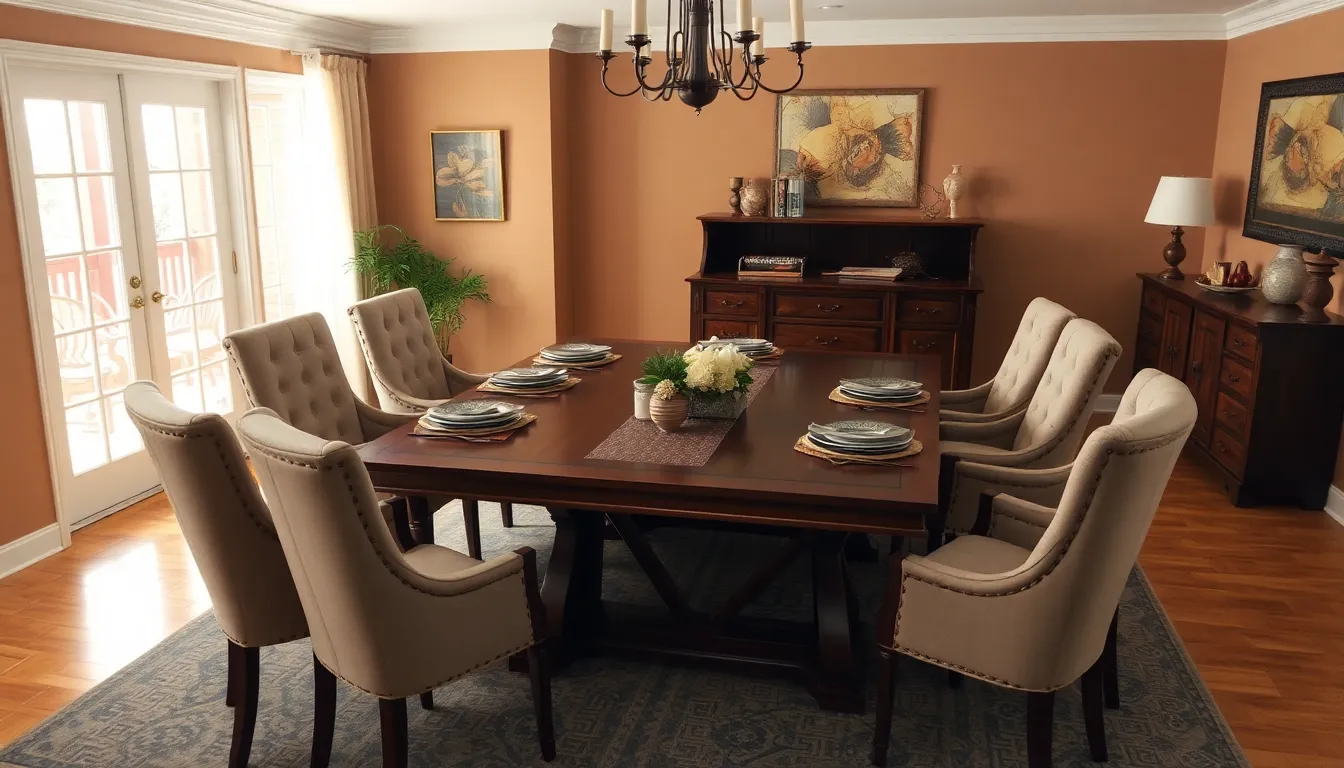
Various types of dining room furniture enhance the functionality and aesthetic appeal of the dining area. Familiarity with these options simplifies decision-making and creates a tailored dining experience.
Dining Tables
Dining tables serve as the centerpiece of the dining space, available in shapes such as round, rectangular, and square. Round tables accommodate intimate gatherings, fostering conversation. Rectangular tables provide ample room for larger groups, often fitting within elongated spaces. Material choices include solid wood, metal, and glass, each offering unique styles. For instance, wooden tables showcase traditional warmth, while glass tops offer a modern, airy feel. Adjustable or extendable tables increase versatility, making them ideal for hosting events.
Dining Chairs
Dining chairs complement tables while ensuring comfort. Options range from upholstered armchairs that offer support and style to sleek wooden chairs that favor minimalist aesthetics. Seat height and backrest design vary, affecting comfort during mealtime. Dining chairs can also feature armrests for added support or be stackable for convenient storage. Styles incorporate contemporary, traditional, and eclectic designs, promoting individual expression. Selecting chairs that match the dining table enhances visual cohesion.
Sideboards and Buffets
Sideboards and buffets provide additional storage and surface space in the dining room. Sideboards typically offer cabinets and drawers for storing tableware, linens, and utensils, while flat surfaces allow for decorative displays and serving trays. Buffets stand lower to the ground, ideal for placing food items during meals, enhancing serving efficiency. Both furniture types come in various styles and finishes, contributing to the overall design theme of the room. Choosing functional pieces enhances organization while improving the room’s appeal.
Materials Used in Dining Room Furniture
Various materials shape dining room furniture, impacting aesthetics, durability, and maintenance. Understanding these materials helps in selecting the right furniture for a desired look and functionality.
Wood
Wood dominates dining room furniture due to its timeless appeal and sturdiness. Solid wood, such as oak, maple, and walnut, provides durability and a natural grain, enhancing the overall design. Engineered wood options, like plywood or MDF, offer cost-effective alternatives with good stability, though they may lack the unique character of solid wood. Finishes, including stain and paint, allow customization, enabling a match to various decor themes.
Metal
Metal furniture brings a contemporary edge to dining spaces. Stainless steel and wrought iron are common materials, known for their strength and resistance to wear. Metal frames often support tabletops made of glass or wood, balancing aesthetic appeal with functionality. Maintenance is uncomplicated with metal; a simple wipe-down keeps furniture looking new. Metal accents in chairs or tables can introduce an industrial or modern vibe to traditional dining areas.
Upholstery Fabrics
Upholstery fabrics contribute comfort and style, essential for dining chairs. Common fabrics include cotton, linen, and polyester, each offering unique textures and patterns. Leather or faux leather provides a sleek, luxurious look while being easy to clean. Upholstered chairs may incorporate foam padding for comfort during long meals. Understanding fabric durability and maintenance requirements is crucial, especially in homes with children or pets.
Tips for Choosing Dining Room Furniture
Selecting dining room furniture involves balancing style, size, and practical needs. Thoughtful choices enhance both aesthetics and functionality in the dining space.
Style Considerations
Identify a cohesive design theme to ensure all pieces complement each other. Options include traditional, modern, rustic, or eclectic styles. Match dining tables and chairs with existing décor for a harmonious look. Consider colors, finishes, and materials that align with overall room aesthetics. Incorporate a statement piece, such as an intricately designed dining table, to serve as a focal point. Accessories like table runners and centerpieces can further enrich the style without overwhelming the space.
Size and Space Planning
Measure the dining area accurately to determine appropriate furniture dimensions. Allow 36 to 48 inches of space around the table for comfortable movement and chair placement. Choose a table size that accommodates the desired number of guests without cramping the room. For smaller spaces, consider round or extendable tables to maximize flexibility. Ensure chair height and table height are compatible for optimal comfort. Utilize area rugs to visually define the dining space and provide additional warmth. Efficient planning enhances both usability and the overall ambiance of the dining room.
Maintenance and Care for Dining Room Furniture
Maintaining dining room furniture ensures its longevity and aesthetic appeal. Regular cleaning and specific care methods depend on the materials used.
Wood Furniture
- Dust Regularly: Use a soft, dry cloth to remove dust and prevent scratches.
- Avoid Moisture: Keep surfaces dry; excess moisture can warp or damage wood finishes.
- Use Coasters: Protect against heat and moisture from dishes or drinks to prevent stains.
- Apply Polish: Use a suitable furniture polish periodically to enhance shine and protect the finish.
Metal Furniture
- Wipe with a Damp Cloth: Clean regularly with a damp cloth for a polished look; avoid abrasive cleaners that could scratch.
- Check for Rust: Inspect for rust and address it promptly with rust remover or by applying antirust paint.
- Use a Furniture Wax: Applying wax helps maintain shine and protects metal finishes.
Glass Furniture
- Use Glass Cleaner: Regularly clean with a dedicated glass cleaner to maintain clarity and shine.
- Remove Smudges Promptly: Immediately wipe off food or drink spills to prevent staining.
- Handle with Care: Lift glass furniture carefully to avoid chipping or breaking.
Upholstered Furniture
- Vacuum Regularly: Use a vacuum with an upholstery attachment to remove dust and crumbs.
- Treat Stains Quickly: Respond to spills with a suitable upholstery cleaner; blot instead of rubbing.
- Avoid Direct Sunlight: Position away from sunlight to prevent fading.
General Tips
- Rotate Chairs: Periodically rotate chairs to promote even wear on upholstery and frames.
- Inspect Joints: Regularly check for loose joints and tighten as necessary to maintain stability.
- Store Properly: When not in use, consider covering furniture or storing it in a climate-controlled space.
Implementing these maintenance strategies sustains the beauty and functionality of dining room furniture, ensuring it serves as a welcoming centerpiece for gatherings.
Selecting the right dining room furniture is essential for creating a space that fosters connection and warmth. Thoughtful choices in tables, chairs, and storage solutions can significantly enhance both the functionality and aesthetics of the room. By understanding different styles and materials, individuals can make informed decisions that reflect their personal taste while meeting practical needs.
Maintaining this furniture ensures it remains a beautiful centerpiece for gatherings. With proper care and attention, dining room furniture can continue to serve its purpose for years to come. Ultimately, investing time in selecting and caring for dining room furnishings transforms the area into a welcoming environment for family and friends alike.

